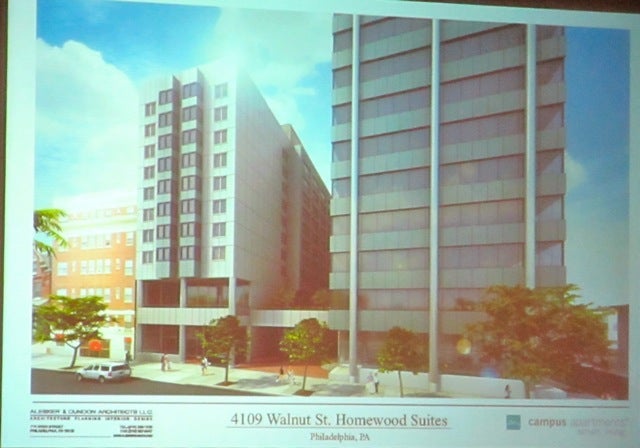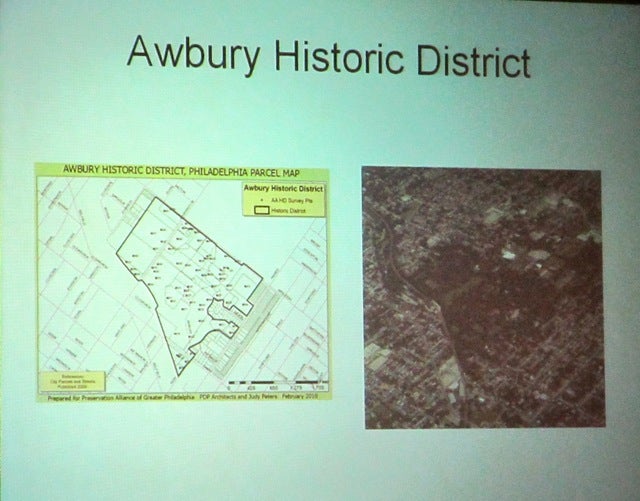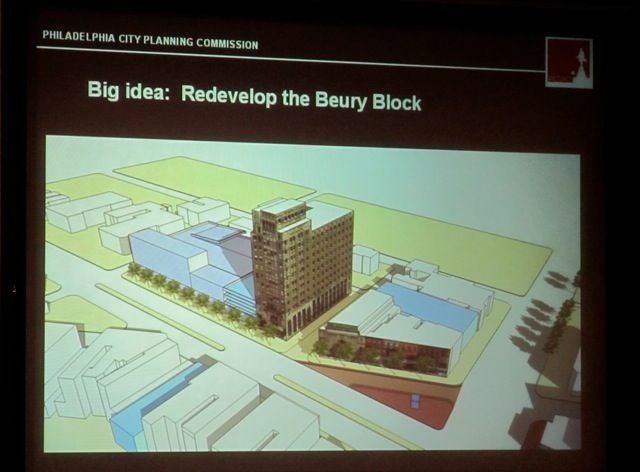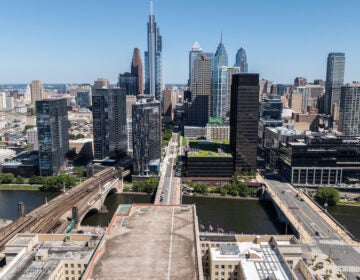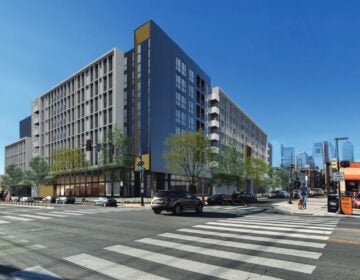PCPC: All about arboretums, hotels, streets and 2035
March 16, 2010
By Thomas J. Walsh
For PlanPhilly
The Philadelphia City Planning Commission voted to approve a new historic district in Germantown, gave a nod to a new transit-oriented development plan on North Broad Street, and gave a green light to institutional zoning changes in University City at its monthly meeting Tuesday afternoon. It also heard the latest of several “information only” presentations for the delayed Hilton Homewood Suites extended-stay hotel at 41st and Walnut streets.
Executive Director Alan Greenberger, also acting deputy mayor for planning and commerce, was absent due to budget testimony he was giving at City Hall. In his place, Deputy Executive Director Gary Jastrzab updated the commissioners about ongoing business, including the finalization of plan-of-development regulations for the Central Delaware River waterfront.
Jastrzab said some revisions were being made, which would be emailed to the commissioners in the next few days. The regulations will also be posted to the commission’s web site, with the hope that they will come back to the agency for approval at its April meeting.
Philadelphia2035 update
Danielle DiLeo Kim, director of special projects for the Planning Commission, gave an update of the “Philadelphia2035” plan, which is at the tail-end of the first of four phases of work, collecting and analyzing the project’s goals. An external advisory board was convened during the past month, she said, which helped to re-work the long-range plan’s themes and visions. The original four broad concepts (“Grow, Sustain, Connect, Celebrate”) were refined to “Thrive,” “Connect” and “Renew.”
The advisory board consists of representatives from the business community, institutions and community groups spread out into five working committees: civic engagement; communications; content review; policy development; and implementation. The board will meet four times before January 2011.
The “Thrive” aspect addresses development concerns, neighborhoods, economic district and centers; and land resources, DiLeo Kim said. The “Connect” part includes transportation and utilities, and the “Renew” portion concerns open space; cultural and historical resources; environmental resources; and the public realm (design excellence).
Broad & Erie
Staffer David Fecteau, of the commission’s Community Planning division, presented the Broad and Erie “transportation and community development plan” for formal adoption. The project was made possible through an $80,000 grant from the Delaware Valley Regional Planning Commission, and took a year to complete. It included nine public meetings and discussions with city agencies and private organizations. Fecteau said 16 previous studies and grants were examined for lessons learned. Partners on the project were Gannett Fleming, a Camp Hill, Pa.-based planning, design, and construction management firm; Urban Partners of Philadelphia; and Baker & Co. LLC, a Philadelphia management consultant.
The study area is bounded by 10th and 20th streets and Indiana and Hunting Park avenues. Objectives were identifying improvements to transit infrastructure, creating a strategy for targeted neighborhood renewal, and ensuring “that new development relates to transit. The plan includes recommendations for Broad Street, north of Allegheny Avenue, Germantown Avenue, and parts of the Tioga and West Tioga neighborhoods.”
There are three Broad Street line subway stops and eight bus routes in the area, including one of the busiest subway stations in the city at Erie. Fecteau said recent investment includes Temple Health System’s 11-story Medical Education and Research Building at Broad and Venango; a planned office building to house Community Legal Services near the southwest corner of Broad and Erie; and new subsidized housing units in Tioga. Opportunities for investment include the Beury Building, a 14-story historic landmark just north of Broad, at Erie and Germantown.
Though the neighborhood’s population continues to decline, like the rest of the city it is at a slower pace than in past decades. It has a stable employment base, Fecteau said, and housing values are rising slightly, with an increase in rental housing and rent rates. And though there is a high business retention rate, there is also a great deal of “unmet retail potential.” The neighborhood could definitely use a 50,000 square-foot supermarket, for example, but there is no available contiguous land to develop one.
Other major ideas are to build a new Tioga-Nicetown Library, across Broad from the current one, which “looks like a prison,” Fecteau said. Other nearby buildings could be converted into apartments and retail spaces, and a string of automotive shops could form a new “Auto Services District,” where owners are given incentives to improve their facility’s appearance and encouraged to work with the school district’s vocational training programs.
Adopting this plan would mean that the major recommendations would contribute to the city’s comprehensive planning process, said Jastrzab.
“Knowing the neighborhood like I do, it’s exciting,” said Commissioner Nilda Ruiz. “I like it.”
The staff’s recommendation was for adoption of the plan, and the commission voted unanimously to do so.
Awbury Historic District
The Philadelphia Historical Commission, set to consider the creation of the Awbury Historic District at its May meeting, sought comment from the Planning Commission Tuesday on the designation. In this instance, the Historical Commission requested that Planning recommend creation of the district and deem it compatible with long-term plans for the area.
The proposed district is in East Germantown at the Awbury Arboretum. It is bordered by the R7 SEPTA Chestnut Hill East rail line, Chew Avenue, Avonhoe Road, E. Haines Street, Devon Place, Ardleigh Street, and the arboretum’s property line northwest of E. Washington Lane.
The district would consist of “the designed landscapes, buildings, and sites of the Cope extended family enclave,” including Awbury Arboretum itself, and adjacent properties developed and occupied by Henry Cope (1793-1865), the son and successor to prominent Philadelphia Orthodox Quaker merchant Thomas Pym Cope (1768-1854), and his descendents.
“The houses were built by successive generations of the family in the Gothic Revival, Italian Villa, Queen Anne, Tudor Revival, and Colonial Revival styles between 1849 and 1922, and designed by a series of prominent architects including Thomas Ustick Walter, Addison Hutton, Brockie & Hastings, Carl Ziegler, Cope & Stewardson, and Edmund Gilchrist,” said Erin Cote, presenting for the Historical Commission. “In 1916, the Awbury Arboretum was established as a public park” with the donation of fifty-five acres from the Cope family.
The commission voted to approve the district, which Cote said was originally submitted by the Preservation Alliance of Greater Philadelphia, in conjunction with residents.
U. City plans for Walnut Street
Carl Primavera, a zoning and land use attorney at Klehr Harrison Harvey Branzburg, representing the developer of a Hilton Homewood Suites Hotel proposed for 41st and Walnut streets, gave another “information only” presentation on the project, this time preceding an ordinance to change the zoning code for the entire block, owned by Campus Properties.
The commission’s Bill Kramer said all details would be in place by the April meeting.
Primavera said that the concept was to get the developer’s entitlement, build the hotel, and in time perhaps build out the remainder of the site if market conditions allow. Campus envisions an office building to replace houses that are now adjacent to the hotel site, where Campus Properties could have its headquarters.
He also stated that the project is in line for “new market tax credits” if it is underway by September.
Primavera and the project’s architect presented a flurry of slides – photos (of the current site and digitally enhanced versions with the buildings), blueprints and renderings, frequently moving back-and-forth between them.
Commissioner Joe Syrnick, the acting chair of the meeting, put the brakes on by saying that he had no comprehension of the total plan as presented. “Perhaps you could do it in a way that I can understand,” he suggested.
Brian Abernathy, on the commission now in lieu of the city’s managing director, said, “This is a very convoluted and confusing process. I think we need to get a better sense of why this decision is being made.” He then clarified that the ordinance was not a re-zoning, but rather a change to the underlying classification of the site and structure.
Primavera said he was moving forward in a way suggested to him by Greenberger, who he said told him, “Let’s be forward-thinking.”
“This actually allows us to plan,” Primavera said. “Alan Greenberger told us, ‘Let’s be forward-thinking.’ …We’re asking for what we think we’ll need in the future in order to do the full build-out.”
Commissioner Nancy Rogo-Trainer wondered aloud if the legislation wasn’t like the “spot-zoning” that was commonplace in previous mayoral administrations. “What’s the public good?” she asked.
Primavera said it was a project that amounted to “one plus one equals 10,” rather than adhering to the antiquated zoning code that is very much still in place, despite the best efforts of the multi-year Zoning Code Commission re-write. He also said the endeavor is getting $20 million in public subsidies, and that representatives of the Philadelphia Industrial Development Corp. deem the project important.
“Penn is woefully underserved” for extended stay hotels, he added. The hotel would serve the university’s high-profile proton therapy lab for those receiving treatment and those getting training there, too. “We’re zoning the entire block so we don’t just do it short-sighted. I think that’s what the city wanted. … We think there’s a lot of benefit here.”
More Penn planning
Also discussed Tuesday was an amendment to Penn’s institutional development district and its 186-acre master plan – for Walnut Street between 32nd and 33rd streets.
Marty Gregorski, a commission development planner, said the amendment will permit Penn to demolish the Edison Building (3221 Walnut) to make way for the creation of the new Krishna P. Singh Center for Nanotechnology. This new structure, which is supposed to earn a LEED silver certification, will house lab space, conference rooms, classrooms and public spaces, all of it geared toward the science of nanotechnology. The building is planned to be three stories with about 65,500 square feet of space.
The staff’s recommendation was for approval, and the commission obliged.
Zoning bills
The commission approved one zoning bill, delayed a second, and denied a third.
Gregorski presented a bill (introduced for Council President Anna Verna in February) that would amend the zoning code by expanding the boundaries and making technical changes in the city’s “Off-Street Parking Control District.”
The district consists of the area south of Chestnut Street along Broad Street to Oregon Avenue (extending east to the Delaware River) and to Washington Avenue (extending west to the Schuylkill). The bill would expand the area to include the blocks from Washington south to Moore Street and west to 25th Street. (along with a few blocks at Grays Ferry Avenue and Ellsworth Street).
“What we’re going to be doing is basically adding Point Breeze in,” Gregorski said. “If it turns out that there’s a need to extend it further, we can do that.”
In short, the bill will prevent more homeowners from building first-floor garages that face the street. “This ordinance would provide another level of review,” said Jastrzab. Cars parked in what otherwise is the living room of most rowhomes “take away from the urban fabric” of the neighborhood, he said, and create curb-cuts that take street parking spots away from neighbors.
The bill changes the requirement for the addition of parking spaces (for new single- or two-family homes) from a “matter-of-right permit” to one requiring a certificate from the Zoning Board of Adjustment.
The staff’s recommendation was for approval, and the commissioners voted accordingly.
*
Another bill proposes amending the zoning code by adding a new section called the “Ridge Avenue Special District Controls.”
The bill includes a new overlay to affect all properties zoned “C2” commercial with frontage on Ridge Avenue in Roxborough, between Hermitage Street and Monastery Avenue. The overlay would place new use, height, façade and signage controls on C2 properties within the district.
“Certain auto-related uses,” temporary employment agencies, warehouses and wholesale showrooms would be prohibited in the newly designated district. Also, “in an effort to permit only active uses on the ground floor,” certain uses would be prohibited on the ground floor of district properties. They include professional offices, funeral parlors, laboratories, personal services, treatment of patients, radio or television studios, and certain utilities. Other restrictions are too numerous to list here.
The staff’s recommendation was for approval: “The community had hired a consultant to draft legislation, which would have the effect of revitalizing Ridge Avenue in Roxborough,” their report states. “The PCPC staff has been working with them over the course of a number of years to help craft a Bill that could be introduced.”
Gregorski said the bill, which affects only new uses, “has been floating around for a couple of years. … The community is aware – they are for it.”
Whether the overlay survives the new zoning code we can’t say, he added. “We’re hoping this won’t be necessary” in the new code.
The bill, though, might go too far with the restrictions on ground floor uses and other regulations, the commissioners said, during an ensuring conversation. Hair salons, for examples, would not be allowed for ground level retail, even though they tend to drive foot traffic, not deter it.
In the end, though Gregorski stressed that it was a community-driven plan, no one from Roxborough was present at the meeting. Motion was passed for a 45-day extension on approval so that representatives of the neighborhood’s community development corporation could talk directly with the commissioners.
*
The commission staff recommended disapproval of a Streets Department bill (introduced by Councilman Frank DiCicco last September) that would authorize the striking of tiny Marshall Street (from Bainbridge to Kater Streets in Queen Village, between 6th and 7th streets) from the city plan.
The use proposed by a property owner there (or more than one – it was not exactly clear) was for a paved private driveway with a gate. The city would retain right-of-way for various utilities. The gate would ostensibly be open in the daytime to allow the public to use the street as a pedestrian thoroughfare.
Trash dumping and public urination are problems for the half dozen or so homeowners whose properties back onto the street, they contend.
But staffer Bill Erickson said the staff recommended disapproval of the scheme because of the city’s overall movement toward pedestrian-friendly planning. And despite the property owners’ intentions with the gates, “To lose the alleys and the walking areas just seems to be going in the opposite direction,” Erickson said. “We just don’t see the point of losing this connection.”
Erickson also said the point person for the owner (or owners; none were present) who have sought the striking of the street asked that the commission either approve it or table it until a date when he could make it to the meeting.
Rogo-Trainer noted that “there are hundreds, if not thousands of these little streets throughout the city,” and that it didn’t appear from photos that the owners were taking care of sidewalks adjacent to their properties as it is.
Others, too, pointed out the weed-choked appearance of the alley, noting that it was obviously already being used for illegal parking. Jastrzab also questioned the shaky nature of accountability: who would open the gates each morning, and at what time? Who gets keys? What’s the quality of the gates?
“The staff feels this would set a bad precedent,” said Jastrzab.
Commissioner Pat Eiding had heard enough. “This city has a lot of little streets … you’d have this all over the place. If they’d have the parties of interest just get out there and clean it up, they’d have a nice little street.”
The commissioners voted unanimously to disapprove the bill.
Contact the reporter at thomaswalsh1@gmail.com.
WHYY is your source for fact-based, in-depth journalism and information. As a nonprofit organization, we rely on financial support from readers like you. Please give today.



